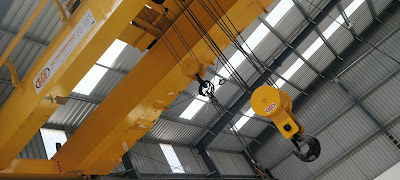Learn the differences between Chain and Wire Rope Hoists
Hard work gear is basic to each industry, regardless of
whether it be aviation, development, car, or nourishment and refreshment.
By utilization of manual or electric task, derricks can move
overwhelming burdens vertically utilizing a drum or lift-wheel. Of these
cranes, there are two principle electric sorts that industry experts depend on
– chain or wire rope lifts. While examining a lifting job that needs to be
done, the most vital elements to consider for every one of these cranes is
application type, natural conditions, limit and obligation cycle.
Chain lifts lift by pulling the chain through sprockets and
moving the chain into a chain holder. These sorts of derricks are all the more
ordinarily utilized for applications with burdens beneath 10 tons and require
considerably less upkeep rather than wire rope lifts.
Chain lifts are additionally extraordinary in that they give
genuine vertical lift, which means they rise straight up with positively no
sidelong development.
Genuine vertical lift is utilized for applications requiring
greatly exact vertical position. Chain lifts fill in as a temperate option for
less requesting occupations in shops and rougher conditions.
Chain lifts are reasonable for such circumstances since they
are normally encased and ensured against synthetic concoctions or open air
components.
Then again, wire rope lifts lift stacks by folding a link
over a notched drum. For 10 tons or more, wire rope lifts are the ideal
decision available. This class of cranes is commonly known to offer a more
extensive assortment of alternatives with quick lifting paces.
Wire ropes are the favored decision for successive use as
chain lifts are increasingly powerless to mileage after some time. Wire ropes,
be that as it may, move stacks marginally along the side in light of the fact
that the wire rope is folded over a scored drum.
In spite of the fact that the sidelong development is
insignificant, genuine vertical lift is just accomplished with chain derricks,
and this is imperative to remember for exact vertical situations for something
like stripping molds.
Obligation appraisals are the last, and maybe most huge
piece in understanding which lift type will give the best strength to your
application.
Characterized by different organizations, raise obligation
orders are distributed measures for material taking care of and quality that
can help recognize which lift is most reasonable for a task. The three most
usually utilized characterizations for electric derricks are FEM, HMI, and
CMAA.
FEM alludes to the European Federation of Materials Handling
which utilizes two fundamental components to give its characterization: stack
range and normal every day working time. This standard is exceptional in the
United States, however may in any case show up in derrick determinations.
HMI is the Hoist Manufacturer's Institute and reports its
characterization utilizing factors like the quantity of lifts every hour, max
number of stops and begins every hour, the normal separation of vertical
development, and lifting recurrence of the heap.
CMAA is known as the Crane Manufacturer's Association of America and bases its qualities on the crane's number of lift cycles joined by
its normal load force. An enormous contrast to remember when taking a gander at
HMI and CMAA numbers is that HMI just rates lifts and not the whole crane.
The most habitually utilized appraisals are HMI and CMAA
when looking at changed derricks. For HMI, hope to see details going from H1
through H4, with H4 showing high volume treatment of overwhelming burdens. When
taking a gander at CMAA appraisals - which apply to cranes-they extend from
Class A through F, with F being the heaviest.
These particulars are only a concise manual for better understanding the distinction among chain and wire rope lifts. Considering variables, for example, the reason and heap of the lift and furthermore breaking down sturdiness and obligation evaluations will set you up for settling on the correct choice about an appropriate derrick for your next task.

Comments
Post a Comment